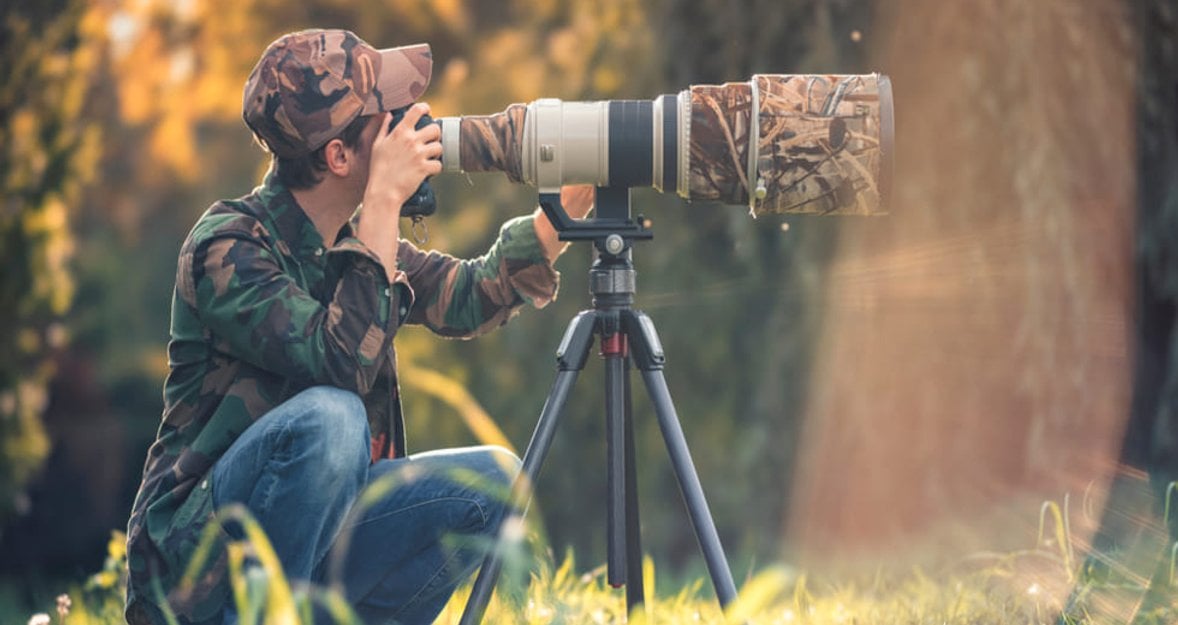10 Tips For Improving Your Wildlife Photography
July 04, 2024

Check out this guide that will walk you through everything you need to know about wildlife photography, from choosing the right gear to fine-tuning your images. It's filled with helpful tips that are perfect for anyone eager to capture stunning scenes! Keep reading!
Hey there! Today, we’ll share some easy tips for wildlife photography to help you capture the beauty of nature with your camera! This guide is perfect for beginners who want to learn the ropes or anyone hoping to improve their shots. First, we will talk about gear and settings, and then we’ll cover all 10 tips! Let's get started and see what we can find outdoors!
Advanced yet easy-to-use photo editor
Get Luminar Neo NowWhat You'll Need
 Are you starting a wildlife photography adventure? Here’s a simple breakdown of the essentials to get you going!
Are you starting a wildlife photography adventure? Here’s a simple breakdown of the essentials to get you going!
Reliable Camera: Grab a camera that won't flinch at a bit of weather and can swap lenses when needed. Make sure it has quick autofocus to capture swift wildlife moments and robust low-light performance — most animals are either dawn or dusk active.
Telephoto Lens: Wildlife often stays far away, so a telephoto lens is essential. Try for something like 300mm to capture clear images from a distance. If money's tight, a 200-500mm zoom lens is a solid and more affordable choice that still gives you the reach you need.
Tripod: To get crisp photos, especially with zoom lenses, a good tripod is important. If you like to move around while shooting, think about using a monopod instead. It’s lighter and easier to handle, which makes setting up quick and simple!
Teleconverter: Looking to get even closer shots without spending a fortune? A teleconverter can extend the reach of your lens at a fraction of the cost, though keep in mind it might slightly reduce the brightness of your photos.
The Best Wildlife Photography Settings
 Start by moving away from your camera's Auto mode — try Aperture Priority to control depth of field and light by setting the aperture and ISO yourself while the camera picks the right shutter speed. Or, if you're focusing on animals in action, Shutter Priority might be better since it lets you set a fast shutter speed to freeze movement, and the camera adjusts the aperture!
Start by moving away from your camera's Auto mode — try Aperture Priority to control depth of field and light by setting the aperture and ISO yourself while the camera picks the right shutter speed. Or, if you're focusing on animals in action, Shutter Priority might be better since it lets you set a fast shutter speed to freeze movement, and the camera adjusts the aperture!
Aim for a balance between aperture and shutter speed to suit the lighting and the subject’s speed. A wide aperture can beautifully blur your backgrounds and draw focus to your subject, but ensure it’s not so wide that parts of your subject blur unintentionally.
As for shutter speed, go quick enough to capture the action crisply — anything from a gentle trot to a full sprint. Adjusting your ISO can help compensate for lower light while maintaining the quality of your shot. Lastly, switching to continuous autofocus can dramatically improve your chances of a sharp shot, as it adjusts focus on the move and tracks unpredictable wildlife effectively!
Wildlife Photographer of the Year: Grand Winners 2023
Learn moreNow, let’s get down to our animal photography tips!
1. Find Magic in the Mundane
 Wildlife photography isn’t just about capturing the obvious giants of the animal kingdom. Look for the subtle beauty in less celebrated creatures. That unassuming bird perched quietly, the play of light on a beetle’s shell — these subjects can be as captivating as any lion or elephant. It’s about seeing the extraordinary in what many might dismiss as ordinary.
Wildlife photography isn’t just about capturing the obvious giants of the animal kingdom. Look for the subtle beauty in less celebrated creatures. That unassuming bird perched quietly, the play of light on a beetle’s shell — these subjects can be as captivating as any lion or elephant. It’s about seeing the extraordinary in what many might dismiss as ordinary.
2. Learn Composition
 Your composition tells the story. How you frame your shot — the elements you include and those you exclude — guides the viewer's experience. Use the environment to your advantage; a fallen log or a stream can lead the eye to your subject. A well-composed photo feels intentional and draws the viewer into your perspective of the natural world.
Your composition tells the story. How you frame your shot — the elements you include and those you exclude — guides the viewer's experience. Use the environment to your advantage; a fallen log or a stream can lead the eye to your subject. A well-composed photo feels intentional and draws the viewer into your perspective of the natural world.
3. Build Layers in Your Photos
 Creating a sense of depth transforms a photo from a flat image to a scene that pulls the viewer in. Position different elements at various distances from your lens — maybe a flower in the foreground, a fox in the middle, and the forest fading into the mist. This setup makes your photo feel more like a window into another world.
Creating a sense of depth transforms a photo from a flat image to a scene that pulls the viewer in. Position different elements at various distances from your lens — maybe a flower in the foreground, a fox in the middle, and the forest fading into the mist. This setup makes your photo feel more like a window into another world.
Best Camera for Beginner Nature Photography: Top Picks
Learn more4. Master Lighting
 Light is the paint of photography. Soft morning or late afternoon light wraps gently around your subject, casts intricate shadows and highlights details with a warm glow. And don’t forget, sometimes what you leave in the shadow can be as powerful as what you illuminate!
Light is the paint of photography. Soft morning or late afternoon light wraps gently around your subject, casts intricate shadows and highlights details with a warm glow. And don’t forget, sometimes what you leave in the shadow can be as powerful as what you illuminate!
5. Keep Your Subject Whole
 Be vigilant about your frame’s edges; it’s all too easy to accidentally clip a part of your subject in the heat of the moment. A full view ensures that the animal is presented in a natural, undistorted way!
Be vigilant about your frame’s edges; it’s all too easy to accidentally clip a part of your subject in the heat of the moment. A full view ensures that the animal is presented in a natural, undistorted way!
6. Back Up Your Photos
 It’s crucial to back up your wildlife photos as soon as you can. Memory cards are handy in the field but shouldn’t be your only storage option. Once you’re home, make sure to transfer your images to something more permanent, like an external hard drive or cloud storage. This way, you won’t lose everything if a piece of equipment fails. It’s better to be safe than sorry when it comes to preserving your work!
It’s crucial to back up your wildlife photos as soon as you can. Memory cards are handy in the field but shouldn’t be your only storage option. Once you’re home, make sure to transfer your images to something more permanent, like an external hard drive or cloud storage. This way, you won’t lose everything if a piece of equipment fails. It’s better to be safe than sorry when it comes to preserving your work!
7. Get to Know Your Subjects
 The more you know about the animal’s behavior and habits, the better your chances of capturing a great shot. Don't just visit briefly and move on; spend time watching and waiting. This patience can pay off hugely when you anticipate an animal’s next move and catch a perfect moment!
The more you know about the animal’s behavior and habits, the better your chances of capturing a great shot. Don't just visit briefly and move on; spend time watching and waiting. This patience can pay off hugely when you anticipate an animal’s next move and catch a perfect moment!
8. The More, The Merrier
 Photos of animals interacting are often more interesting than solo shots. If you see a group, take some time to watch how they interact. You might catch them playing, fighting, or engaging in other behaviors that make for dynamic photos. These moments can add a lot of life and story to your pictures.
Photos of animals interacting are often more interesting than solo shots. If you see a group, take some time to watch how they interact. You might catch them playing, fighting, or engaging in other behaviors that make for dynamic photos. These moments can add a lot of life and story to your pictures.
9. Capture Everything
 Every animal has the potential for a great photo, not just the big or famous ones. Sometimes, the smaller or more common animals provide the best opportunities, especially if you catch them in great light or doing something unusual. So keep your camera out and be ready to capture whatever comes your way, big or small!
Every animal has the potential for a great photo, not just the big or famous ones. Sometimes, the smaller or more common animals provide the best opportunities, especially if you catch them in great light or doing something unusual. So keep your camera out and be ready to capture whatever comes your way, big or small!
10. Don't Overlook the Post-Processing
Editing your wildlife photos breathes new life into the raw images. For photographers looking to enhance their nature captures, Luminar Neo is a powerful AI software that simplifies the editing process. Specializing in editing wildlife photos and nature photo editing, this platform offers user-friendly features that elevate the quality of your images!
With Luminar Neo, you can effortlessly adjust colors, sharpen details, and bring depth to your photos with realistic atmospheric effects. It’s also equipped with an enlarge image feature, perfect for those who want to expand their photos for larger prints or detailed cropping without compromising on image quality.
This software ensures that the time you spend in the field doesn't go to waste and helps you produce polished and professional-looking results that capture the essence of the wild!
Wrapping Up
And there you have it — your starter kit of wildlife photography tips for beginners and pros to snap better photos! It’s all about gearing up right, knowing your camera settings and a bit of patience waiting for that perfect shot. Once you’ve captured what you came for, a little editing can go a long way to make those good shots look fantastic.
Remember, each trip into the wild is an opportunity to improve your skills and add to your portfolio. So keep practicing, stay patient, and explore various techniques to bring out the best in your wildlife subjects.
Grab your camera, get out there, and let nature do the rest!





